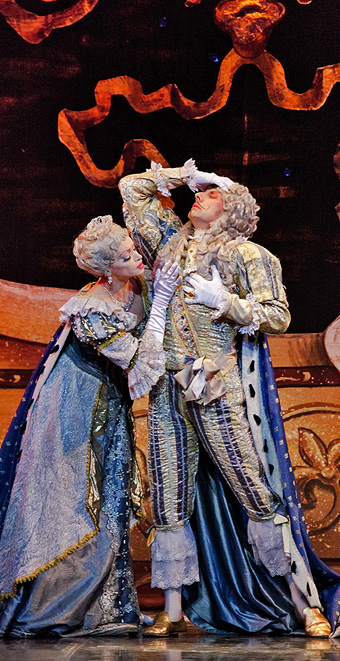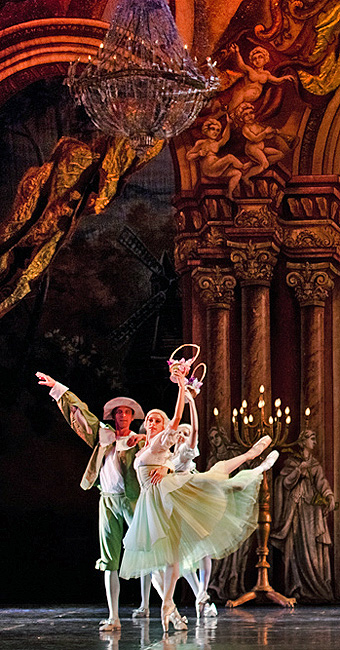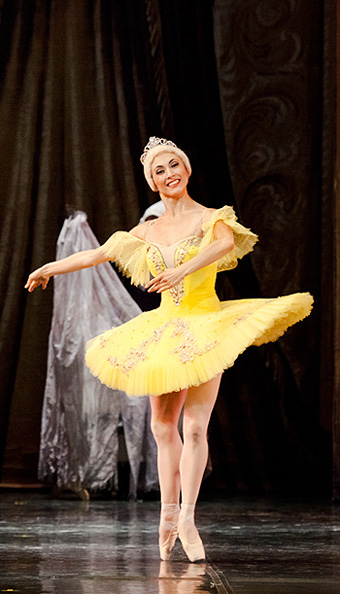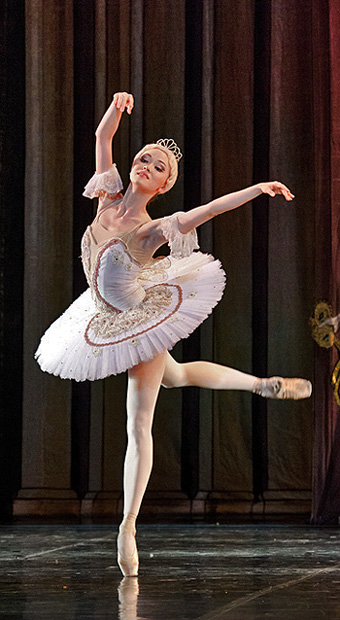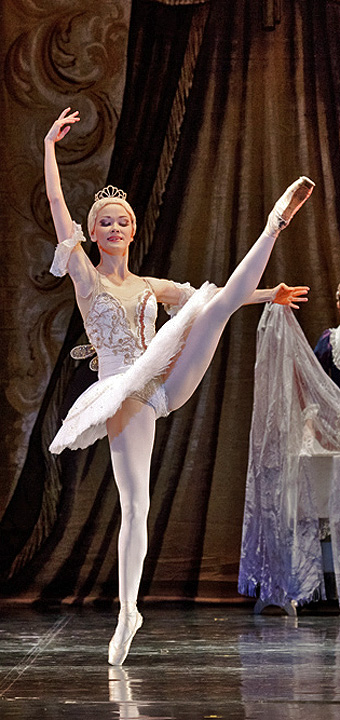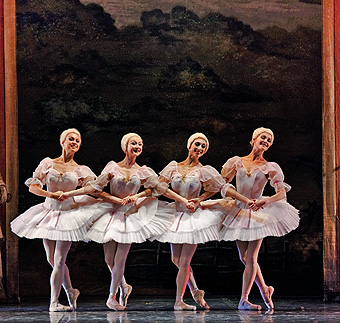

The world-renown Moscow Ballet - La Classique
performing their spectacular masterpiece

demonstrate their continued quality of dance and performances in dramatic productions of timeless favourite sets.
Music by P. Tchaikovsky Choreography by Petipa
This classical masterpiece commences with the christening of Princess Aurora. The King forgets to invite the bad fairy, Carabosse, who bursts into the castle at the conclusion of the ceremony and casts a spell that the Princess will die from a prick of a needle at age 16. The King orders that all knitting needles in the Kingdom are to be destroyed and that anyone who is in possession of a knitting needle will be executed.
16 years later...
The Master of Ceremonies finds four women knitting. He takes the needles from them and brings them before the King who immediately sentences them to death. The King’s wife is horrified and asks the King to pardon them as it is the birthday of their daughter Princess Aurora. The King grants their freedom and the festivities begin.
On her sixteenth birthday, Princess Aurora dances with each of the four princes who have come to ask for her hand. An old woman appears in the hall and presents her with a beautiful bouquet of flowers. However she pricks her finger on a concealed knitting needle hidden in the bouquet of flowers and falls into a deep sleep.
100 years later...
Prince Deserea and his party are hunting for birds in the forest where he encounters the Lilac Fairy. The Lilac Fairy makes him fall asleep and in his dreams the Prince dances and falls in love with Princess Aurora however the Evil Fairy "Carabosse" bursts into the dream, steals the princess and takes her to the castle.
When the Prince awakens he sees the outline of the castle and drawing his sword he charges into the castle where he finds the Princess of his dreams. He kisses her gently and after 100 years sleeping the Princess awakens.
Witchcraft is defeated and all of the court wakes.
A holiday is declared for Princess Auroras Wedding to Prince Deserea. Invited guests are entertained by fairy tale characters, as the joyous occasion is celebrated by the Kingdom.
The Sleeping Beauty (ballet)
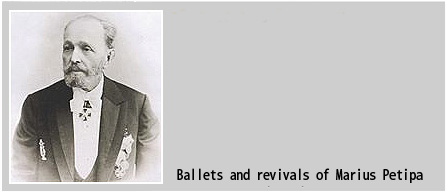
The Sleeping Beauty (Russian: Спящая красавица, Spyashchaya krasavitsa) is a ballet in a prologue and three acts, first performed in 1890. The music was by Pyotr Tchaikovsky (his Opus 66). The score was completed in 1889, and is the second of his three ballets. The original scenario was conceived by Ivan Vsevolozhsky, and is based on Charles Perrault's La Belle au bois dormant. The choreographer of the original production was Marius Petipa
The premiere performance took place at the Mariinsky Theatre in St. Petersburg in 1890.

History
Composition history
Tchaikovsky was approached by the Director of the Imperial Theatres in St. Petersburg, Ivan Vsevolozhsky on 25 May 1888 about a possible ballet adaptation on the subject of the story of Undine. It was later decided that Charles Perrault's La Belle au bois dormant would be the story for which Tchaikovsky would compose the music for the ballet. Tchaikovsky did not hesitate to accept the commission, although he was aware that his only previous ballet, Swan Lake, met with little enthusiasm at that stage of his career. The ballet scenario that Tchaikovsky worked on was based on the Brothers Grimm version of Perrault's work entitled 'Dornröschen'. In that version, the Princess's parents (the King and the Queen) survived the 100-year sleep to celebrate the Princess's wedding to the Prince. However, Vsevolozhsky incorporated Perrault's other characters from his stories into the ballet, such as Puss in Boots, Little Red Riding Hood, Cinderella, Blue Beard, Ricky of the Tuft and Tom Thumb. Other french fairy tale characters to be featured are Beauty and the Beast, Pretty Goldilocks and The White Cat. Regardless, Tchaikovsky was happy to inform the Director of the Imperial Theatre that he had great pleasure studying the work and had come away with adequate inspiration to do it justice.
The choreographer was Marius Petipa, ballet master of the Imperial Ballet, who wrote a very detailed list of instructions as to the musical requirements. Tchaikovsky worked quickly on the new work at Frolovskoye; he began initial sketches in the winter of 1888 and began orchestration on the work on 30 May 1889.
The ballet's focus was undeniably on the two main conflicting forces of good (the Lilac Fairy) and evil (Carabosse); each has a leitmotif representing them, which run through the entire ballet, serving as an important thread to the underlying plot. Act III of the work, however, takes a complete break from the two motifs and instead places focus on the individual characters of the various court dances.
Performance history:

St. Petersburg premiere (world premiere)
-- Date: 15 January 1890
-- Place: Imperial Mariinsky Theatre, St. Petersburg
-- Balletmaster: Marius Petipa
-- Conductor: Riccardo Drigo
-- Scene Designers: Henrich Levogt (Prologue), Ivan Andreyev (Act 1), Mikhail Bocharov (Acts 1 & 2), Matvey Shishkov (Act 3)
--
Costumes: Ivan Vsevolozhsky
Moscow premiere
-- Date: 17 January 1899
--
Place: Moscow Imperial Bolshoi Theatre
--
Balletmaster: Aleksandr Gorsky
--
Conductor: Andrey Arends
The ballet's premiere received more favorable accolades than Swan Lake from the press but Tchaikovsky never had the luxury of being able to witness his work become an instant success in theatres outside of Russia. He died in 1893. By 1903, The Sleeping Beauty was the second most popular ballet in the repertory of the Imperial Ballet (the Petipa/Pugni The Pharaoh's Daughter was first), having been performed 200 times in only 10 years.
A production mounted at the La Scala in Milan did not arouse much interest and it was not until 1921 that, in London, the ballet finally gained wide acclaim and eventually a permanent place in the classical repertoire. In 1999, the Mariinsky Ballet reconstructed the original 1899 production, including reproductions of the original sets and costumes. Although the 1951 Kirov production by Konstantin Sergeyev is available on DVD/Video, the 1999 "authentic" version is only available in short excerpts as of 2007.
The Sleeping Beauty is Tchaikovsky's longest ballet, lasting nearly four hours at full length - counting the intermissions. Without intermissions (as it appears on several CD sets), it lasts nearly three hours. It is nearly always cut.
At the premier Tsar Alexander III summoned Tchaikovsky to the imperial box. The Tsar made the simple remark 'Very nice,' which seemed to have irritated Tchaikovsky, who had likely expected a more favorable response.
Roles:
The Royal Court:
King Florestan XIV,
Queen,
Princess Aurora, their daughter,
Catalabutte, the master-of-ceremonies,
Courtiers, maids of honor, pages, lackeys
The Fairies:
Candide (Candor),
Coulante, Fleur de farine (Flowing, Wheat flour),
Miettes qui tombent (Falling breadcrumbs),
Canari qui chante (Singing canary),
Violente (Force),
The Lilac Fairy.
Carabosse
The Gold, Silver, Sapphire, and Diamond Fairies
The Four Suitors:
Prince Chéri,
Prince Charmant,
Prince Fortuné,
Prince Fleur de Pois
The Prince's Hunting Party:
Prince Désiré (Florimund),
Gallifron, Prince Désiré's tutor,
The Prince's friends, duchesses, baronesses, countesses, and marchionesses
Fairy-Tale Characters:
Puss-in-Boots,
The White Cat,
Princess Florine,
Bluebird,
Little Red Riding Hood,
The Gray Wolf,
Hop-o'-My-Thumb, his brothers, and the Ogre
Prologue
King Florestan the XXIVth declares a grand christening ceremony to be held in honor of the birth of his daughter, Princess Aurora named after the dawn. An entourage of six fairies are invited to the Christening to be godmothers to the child. They are the Candide Fairy, the Coulante Fairy, the Miettes Fairy, the Canari Fairy, the Violente Fairy and—most importantly—the Lilac Fairy, who is the last to arrive (the names of fairies and their gifts vary in productions). As the fairies are happily granting gifts of honesty, grace, prosperity, song and generosity, they are suddenly interrupted by the arrival of the wicked fairy Carabosse, who is furious at the King's failure to invite her to the ceremony. The King and Queen begin to remonstrate, and the Master of Ceremonies, Catallabutte, intervenes to take responsibility, whereupon Carabosse rips off his wig, laughing. With spite and rage, Carabosse declares her curse on Princess Aurora: she will prick her finger on her sixteenth birthday and die. But all is not lost: the Lilac Fairy, fortunately, has not yet granted her gift to the Princess. She acknowledges that Carabosse's power is immense and she cannot completely reverse the curse. However, she declares, though the Princess shall indeed prick her finger, she will not die, but instead sleep for 100 years until she is awakened by the kiss of a prince. Carabosse departs, and the curtain falls as the good fairies surround the cradle.
![]() It is Princess Aurora's sixteenth birthday. Celebrations are already underway: the atmosphere is festive, made complete with a waltz danced by the villagers with garlands. There are women knitting close by: Catallabutte orders them taken away to prison lest their needles precipitate calamity. The king angrily agrees, as he has decreed. After entreaties by the four princes, the women are reprieved amidst rejoicing. Aurora receives her four royal suitors and their gifts of exquisite roses. Soon after, Aurora is presented with a spindle as a gift from a disguised Carabosse—an object which she has never before seen. Carelessly, she dances with it despite her mother and father's warnings before accidentally pricking herself. She faints. To the horror of all, Carabosse immediately reveals her true wicked self triumphantly, vanishing before the princes can vanquish her. The princes and their attendants depart for their native countries in fear. At that very moment, the Lilac Fairy appears as she had promised. She reminds the remaining guests and the King and Queen of her gift—Aurora will not die, but merely sleep. She then casts a spell of slumber upon the entire kingdom so that they will only awake when Aurora does.
It is Princess Aurora's sixteenth birthday. Celebrations are already underway: the atmosphere is festive, made complete with a waltz danced by the villagers with garlands. There are women knitting close by: Catallabutte orders them taken away to prison lest their needles precipitate calamity. The king angrily agrees, as he has decreed. After entreaties by the four princes, the women are reprieved amidst rejoicing. Aurora receives her four royal suitors and their gifts of exquisite roses. Soon after, Aurora is presented with a spindle as a gift from a disguised Carabosse—an object which she has never before seen. Carelessly, she dances with it despite her mother and father's warnings before accidentally pricking herself. She faints. To the horror of all, Carabosse immediately reveals her true wicked self triumphantly, vanishing before the princes can vanquish her. The princes and their attendants depart for their native countries in fear. At that very moment, the Lilac Fairy appears as she had promised. She reminds the remaining guests and the King and Queen of her gift—Aurora will not die, but merely sleep. She then casts a spell of slumber upon the entire kingdom so that they will only awake when Aurora does.
![]() One hundred years later, Prince Florimund (in the original production, it is Désiré) is at a hunting party with his companions. He is not happy and his hunting party try to cheer him up with a game of blind man's bluff and a series of dances. Still unhappy, he asks to be alone and the hunting party depart. Suddenly, Florimund sees the Lilac Fairy who presents him with a vision of Aurora and he is entranced by her beauty. The Prince pleads with the Lilac Fairy to bring him to see Princess Aurora, to which the latter consents. The Prince discovers the castle, which is now overgrown in thick vines. His first act is to defeat Carabosse. Once past her and inside the castle, the Prince finds Aurora and awakens her with a kiss. The entire kingdom awakes with her. The Prince then declares his love for Aurora and proposes to her. The King and the Queen are happy to give their blessings.
One hundred years later, Prince Florimund (in the original production, it is Désiré) is at a hunting party with his companions. He is not happy and his hunting party try to cheer him up with a game of blind man's bluff and a series of dances. Still unhappy, he asks to be alone and the hunting party depart. Suddenly, Florimund sees the Lilac Fairy who presents him with a vision of Aurora and he is entranced by her beauty. The Prince pleads with the Lilac Fairy to bring him to see Princess Aurora, to which the latter consents. The Prince discovers the castle, which is now overgrown in thick vines. His first act is to defeat Carabosse. Once past her and inside the castle, the Prince finds Aurora and awakens her with a kiss. The entire kingdom awakes with her. The Prince then declares his love for Aurora and proposes to her. The King and the Queen are happy to give their blessings.
Preparations for the wedding are made. On the day of the festivities, different fairies are invited. These are the fairies to bless the marriage – The Gold Fairy, the Silver Fairy, the Sapphire Fairy and the Diamond Fairy. The Lilac Fairy also makes an appearance. Many fairytale characters, such as Puss in Boots and the White Cat, are also among the guests. A golden chain of dances is held, including a Pas de Quatre for the four precious jewel and metal fairies, a dance for Puss in Boots and the White Cat, a Pas de Deux for the Bluebird and Princess Florine, a dance for Little Red Riding Hood and the Wolf, a Sarabande (usually omitted), a Pas de Deux for Aurora and Florimund and finally a mazurka. The Prince and the Princess are wed, and the Lilac Fairy blesses their marriage. The ballet ends with an apotheosis (apothéose) where all the characters make a final bow.
